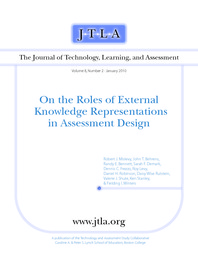
ATTENTION: The works hosted here are being migrated to a new repository that will consolidate resources, improve discoverability, and better show UTA's research impact on the global community. We will update authors as the migration progresses. Please see MavMatrix for more information.
Show simple item record
| dc.contributor.author | Mislevy, Robert J. | |
| dc.contributor.author | Behrens, John T. | |
| dc.contributor.author | Bennett, Randy E. | |
| dc.contributor.author | Demark, Sarah F. | |
| dc.contributor.author | Frezzo, Dennis C. | |
| dc.contributor.author | Levy, Roy | |
| dc.contributor.author | Robinson, Daniel H. | |
| dc.contributor.author | Rutstein, Daisy Wise | |
| dc.contributor.author | Shute, Valerie J. | |
| dc.contributor.author | Stanley, Ken | |
| dc.contributor.author | Winters, Fielding I. | |
| dc.contributor.editor | Russell, Michael | |
| dc.date.accessioned | 2017-09-13T19:33:54Z | |
| dc.date.available | 2017-09-13T19:33:54Z | |
| dc.date.issued | January 2010 | |
| dc.identifier.citation | Published in The Journal of Technology, Learning, and Assessment 8(2):5-57, January 2010 | en_US |
| dc.identifier.issn | 1540-2525 | |
| dc.identifier.uri | http://hdl.handle.net/10106/26926 | |
| dc.description.abstract | People use external knowledge representations (KRs) to create, identify, depict, transform,
store, share, and archive information. Learning to work with KRs is central to
becoming proficient in virtually every discipline. As such, KRs play central roles in curriculum,
instruction, and assessment. We describe five key roles of KRs in assessment:
1. An assessment is itself a KR, which makes explicit the knowledge that is
valued, ways it is used, and standards of good work.
2. The analysis of any domain in which learning is to be assessed must include
the identification and analysis of the KRs in that domain.
3. Assessment tasks can be structured around the knowledge, relationships,
and uses of domain KRs.
4. “Design KRs” can be created to organize knowledge about a domain in
forms that support the design of assessment.
5. KRs in the discipline of assessment design can guide and structure
domain analyses (re #2), task construction (re #3), and the creation and
use of design KRs (re #4).
The third and fourth roles are developed in greater detail, through an “evidence-centered”
design perspective that reflects the fifth role. Recurring implications of technology that
leverage the impact of KRs in assessment are highlighted, including task design supports
and automated task construction and scoring. Ideas are illustrated with “generate examples”
tasks and simulation tasks for computer network design and troubleshooting. | en_US |
| dc.language.iso | en_US | en_US |
| dc.publisher | Technology and Assessment Study Collaborative, Caroline A. & Peter S. Lynch School of Education, Boston College | en_US |
| dc.subject | KRs | en_US |
| dc.subject | External knowledge | en_US |
| dc.subject | Knowledge and learning | en_US |
| dc.subject | Role playing | en_US |
| dc.subject | Assessment | en_US |
| dc.title | On the Roles of External Knowledge Representations in Assessment Design | en_US |
| dc.type | Article | en_US |
| dc.publisher.department | Department of Curriculum and Instruction, The University of Texas at Arlington | en_US |
| dc.identifier.externalLink | www.jtla.org | en_US |
| dc.identifier.externalLinkDescription | The original publication is available at the journal homepage | en_US |
| dc.rights.license | Published open access through the Journal of Technology, Learning, and Assessment | |
Files in this item
- Name:
- On the roles of external knowl ...
- Size:
- 1.487Mb
- Format:
- PDF
- Description:
- PDF
This item appears in the following Collection(s)
Show simple item record


